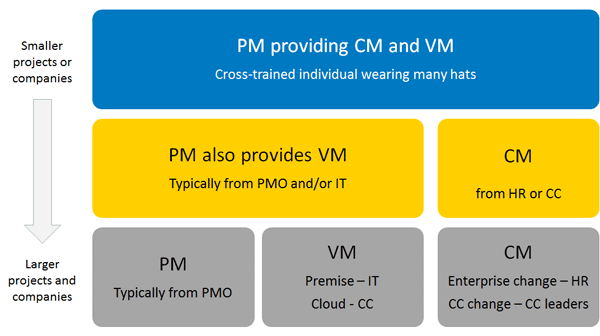We’ve been on our soapbox for years to encourage organizations to adopt the 3 Ms of implementation – Project, Change, and Vendor Management.
- Project Management (PM) focuses on the tasks associated with an implementation – planning, executing, and completing the work of a team to achieve specific goals and meet business objectives.
- Change management (CM) is about helping people adopt the process and technology changes the project presents, and institute practices that will ensure those changes keep delivering business value.
- Vendor management (VM) is about ensuring the vendor and internal project teams are aligned every step of the way, and the vendor’s focus also remains on business success.
PM is a mature practice in most organizations. Yet without CM and VM, the users may not be on board and the vendor may be reassigning staff before the project wraps. Within days or weeks, the technology is underutilized (or ignored), and the knowledgeable vendor resources have moved on.
The different roles suit different personalities and strengths. The PM tends to be logical, task oriented, and can be more technology oriented. CM is a people-oriented job. VM is a combination of the two, with a different twist on the people/communication side than CM: both get people to perform but with different drivers, carrots and sticks.
A perfect world ensures cohesive management across the three disciplines. In practice, we’ve seen several different scenarios.

A PM may wear multiple hats and take responsibility for VM and CM. It is a rare individual who has the bandwidth and skill to do it all well. But when the right person is assigned, it can be great to have everything inherently managed together. Another scenario is when the PM handles VM and works closely with a CM resource. This model enables some specialization while requiring good collaboration. In a third model, the PM oversees tasks and an individual tied to the purchasing decision and/or ongoing vendor relations handles VM. If it’s a premise solution, the VM tends to be in IT. Cloud solutions increasingly place the VM in a business area such as the contact center. Again, collaboration is key.
However the roles are parsed out, a Program Management Office or other oversight group should define what constitutes quality deliverables. PM focuses on project plans, functional requirements, specifications, test plans, status reports, etc. VM includes SOW, SLAs, and vendor project plans. CM includes the plans for communications, training, sponsorship, coaching, and resistance management based on the Prosci® model for change management.
After the technology is in and working, you still need all three Ms. The PM may work on subsequent phases or new tasks related to the main project (and you will benefit immensely if it is the same PM, not a changing of the guard). You need VM to oversee performance and Service Level Agreements (SLAs), deliver new functionality, and keep everyone informed of new system capabilities or options. CM reinforces changes, makes sure customers and staff (frontline and support) are using technology effectively, and addresses adoption issues that can compromise results.
In today’s projects, everyone seems to want to move fast, but resources are limited and risks are high. With good practices around the three Ms, you can move faster and more efficiently.
Want to learn more? Download the full article »
